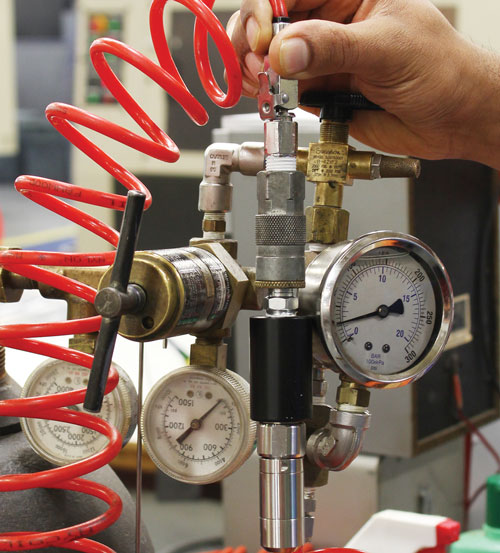Using the Vented Cable Blowout Fitting to dry the vent tube is recommended before starting any new project or before storing the Vented Cable.

Figure 9-4 Vented Cable Blowout Fitting
To use the Vented Cable Blowout Fitting:
Note:
Always follow Personal Protection Protocol when working with a compressed gas.
- Remove the storage caps from both ends of the Vented Cable (remember to save the caps). Or if deployed, remove the logger and Wellhead.
- Connect one end of the Vented Cable to the correct connection on the Blowout Fitting. Ensure proper alignment before pushing the connection together. Twist the stainless steel coupling onto the Blowout Fitting until it seats. Do not twist the Vented Cable, cable connector body, or Blowout Fitting.
Note:
Do not twist the Blowout Fitting, Vented Cable or stainless steel cable connector body when connecting to the fitting. Only twist the stainless steel coupling.

Figure 9-5 Vented Cable Connected to the Blowout Fitting
- Connect the other end of the Blowout Fitting to the nitrogen gas tank hose fitting.

Figure 9-6 Nitrogen Gas Being Blown Through
the Vented Cable
- Slowly apply 25-30 psi of nitrogen gas to the Vented Cable. Let pressure flow through the cable for about 5 minutes. If you hear no air flow, you can apply up to 50 psi of pressure to clear any blockages.
- Turn off the nitrogen gas flow and remove the Vented Cable from the Blowout Fitting.
- If deploying the datalogger, immediately connect one end of the Vented Cable to the logger, and the other to the Wellhead. See Section 1.5.1 for connection instructions.
- If storing the Vented Cable, immediately install the storage caps to both ends of the Vented Cable.
Note:
Do not exceed 50 psi of pressure when using the Vented Cable Blowout Fitting.





